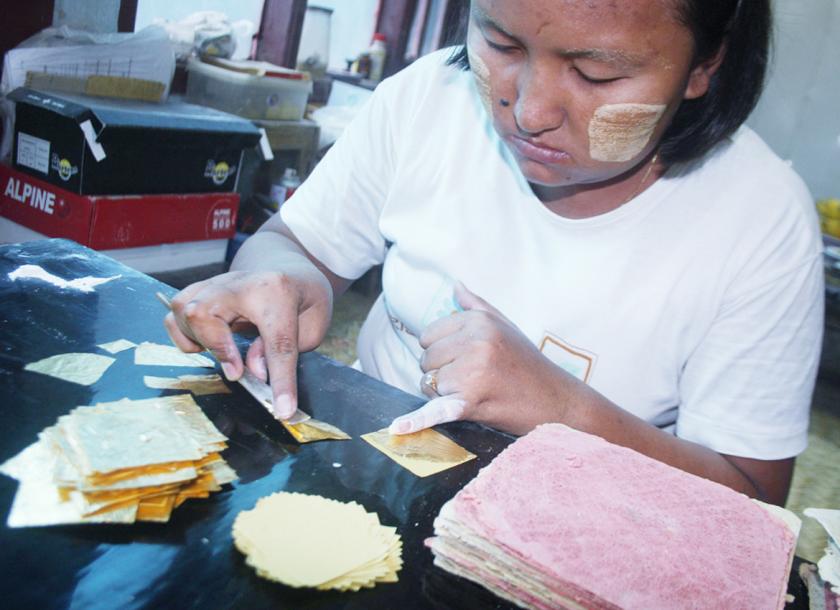Myanmar: Gold leaf making business faces competition, disruption
Concerns of disruption and job losses are mounting among Myanmar’s gold leaf makers as demand rises for a swifter, more economical option to produce gold leaf sheets, used mainly for gilding at religious structures like pagodas. Now that machines capable of manufacturing gold leaf sheets are more readily available and affordable, the handmade industry is feeling the heat.
Compared to those that are handmade, machine-made sheets have a shorter manufacturing time and lower labour costs, resulting in cheaper prices for the end product, said U Myo Min Thein, an employee at Shwe Thein Min Gold Leaf Business in Myat Par Yat, Maha Aung Myay township, which is in the Mandalay Region.
Gold leaf machines are imported mainly from China at around K3.5 million each, but higher quality machines from Japan are also available at K20 million. There are 10 steps for making gold leaf sheets. The process takes about 5 hours while machine-made gold leaf only takes a few minutes, he said.
Currently, the market price is K43,000 for every hundred 2-inch-thick gold leaf sheets. In comparison, machine-made sheets cost around K39,000, said U Maw Thin from Nilar Gold Leaf Industry in Myat Par Yat.
Concerns, competition
If demand for machine-made sheets from the pagodas continues to rise, businesses which produce them by hand will start closing down, said U Myo Min Thein. “If given an option between handmade or machine-made, these days, the majority of the domestic religious bodies, particularly in Yangon, will go for machine-made, including Shwedagon Pagoda,” he said.
Indeed, while most traditional gold leaf makers are located in Myat Par Yat, which houses up to 200 businesses, Shwe Pyi Thai Industrial Zone in Yangon is responsible for producing the highest volume of gold leaf sheets in Myanmar
“Machine-made gold leaf workshops are still not very widespread in Mandalay. Right now, the machine-made gold leaf sheets cannot replace traditional handmade ones. But competition is rising and our work may become obsolete soon,” U Myo Min Thein said.
“Out of direct sunlight, machine-made gold leaf sheets are almost an exact replica of Myat Par Yat handmade sheets. Moreover, handmade sheets require heavy manpower and longer lead times. If other businesses using machines emerge here, we will face many difficulties,” said Ma Su Su Yee from Nan Oo Lwin Gold Leaf Business in Myat Par Yat.

Gold leaf workers pounding gold into thin sheets used for gilding. Phyo Wai Kyaw/The Myanmar Times
Handmade quality
Nevertheless, obsolescence is still a while away and Myat Par Yat businesses still have time to plan ahead. That’s because demand for hand crafted gold leaf sheets from many famous religious sites and pagodas such as Mandalay’s Maha Myat Muni Pagoda and Kyaiktiyo Pagoda in Mon State have so far been purchasing only handmade sheets, according to U Myo Min Thein.
The Maha Myat Muni and Kyaiktiyo pagodas currently purchase around 200,000 handmade gold leaf sheets from businesses in Myat Par Yat. Combined with demand from the rest of the nation, the industry still produces between 500,000 and 700,000 sheets by hand. “So, the handmade business still has an advantage over machine-made for now,” said U Myo Min Thein..
The main reason is better quality. “When you examine the percentage of real gold in the handmade sheets, it will be close 100 percent. It cannot be made with a low gold percentage. When gilding, you can apply handmade sheets however you desire. But for the machine-made sheets, although the thickness can be produced as necessary, the percentage of real gold used has to be inspected,” said U Myo Min Thein.
In fact, making gold leaf sheets by hand goes back for decades and is ingrained in the local culture, according to the Myanmar Traditional Gold Leaf Entrepreneurs Association. Meanwhile, Myat Par Yat is renowned for its gold leaf industry.
“However, the government has no strong interest in supporting our industry. Although gold leaf businesses in Myat Par Yat submitted letters to the Ministry of Culture for support in August 2014, there was no response,” said U Myo Min Thein.
It appears that even if Myat Par Yat manages to survive and adapt to the disruptions ahead, the age-old culture of producing gold leaf sheets by hand may soon be buried in history.
Source: https://www.mmtimes.com/news/gold-leaf-making-business-faces-competition-disruption.html


 Thailand
Thailand




